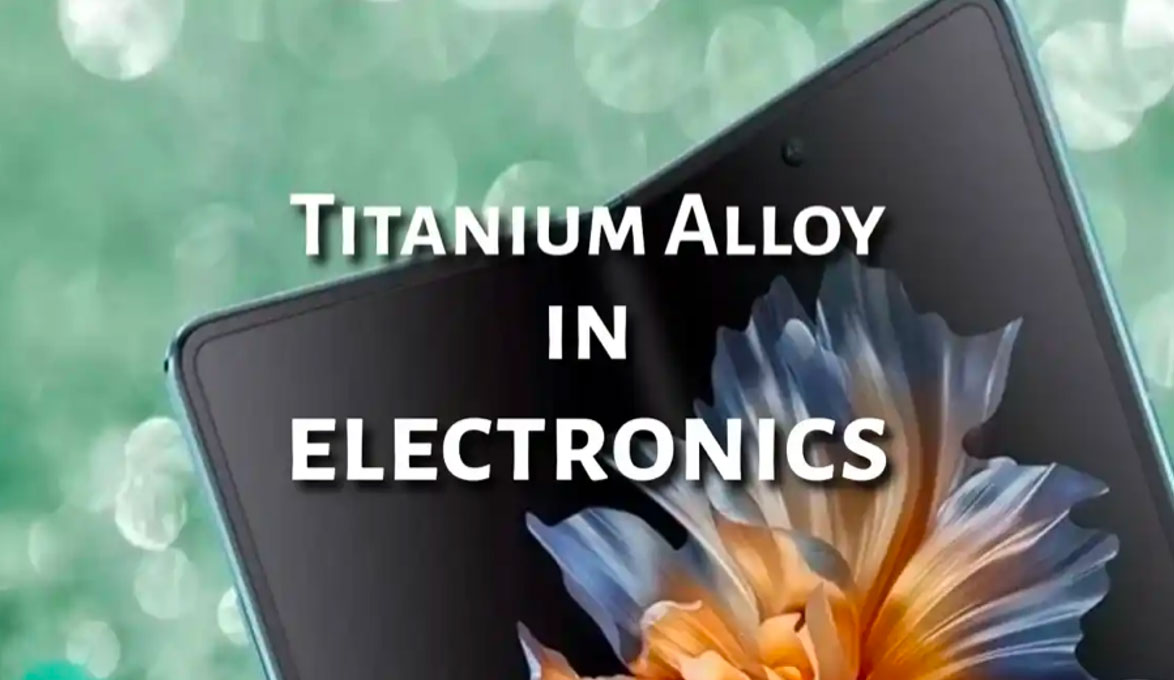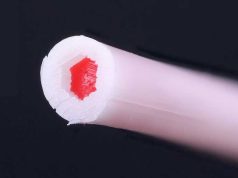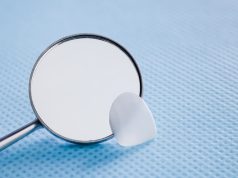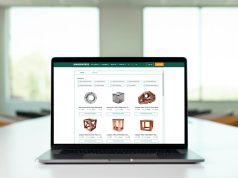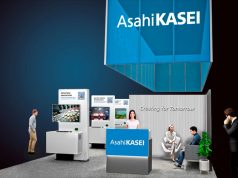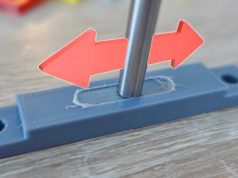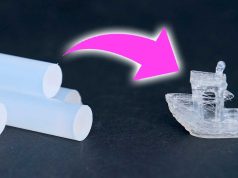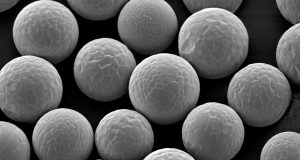Titanium alloy is a metal composed primarily of titanium and other metallic elements like aluminum and vanadium. It possesses unique properties making it well-suited for electronics applications.
Guest article by Unionfab
Titanium: The Versatile Metal
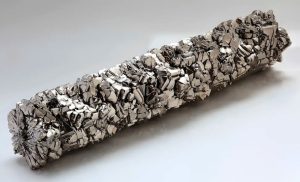
This file is licensed under the Creative Commons Attribution-Share Alike 3.0 Unported license.
Titanium alloy possesses high strength, strong corrosion resistance, and excellent tolerance to high and low temperatures. It finds wide applications in aerospace, aviation, ships, weapons, biomedical, chemical metallurgy, marine engineering, sports, and leisure.
High Strength and Low Density: Titanium alloy exhibits remarkable strength and hardness while maintaining a relatively low density. This combination provides robust structures with reduced weight.
Excellent Corrosion Resistance: Titanium alloy exhibits outstanding corrosion resistance, able to withstand acids, bases, and salt exposures. Its passive layer shields against corrosion and oxidation effects.
Good Biocompatibility: With low toxicity and compatibility with human tissue, titanium alloy is extensively used in implants and medical devices. It avoids allergic responses while promoting bone growth and healing.
Ease of Machining: Titanium alloy has excellent formability and can be processed through various techniques such as forging, spinning, casting, and powder metallurgy.
High-Temperature Performance: Titanium alloy maintains stable performance in high-temperature conditions, exhibiting resistance to oxidation and thermal corrosion. Thus, it commonly features in aerospace, jet engine, gas turbine, and other high-heat components and frameworks.
| Feature | Description |
| Small Density, High Specific Strength | Density of 4.51 g/cm³, about half of copper and low carbon steel, with significantly high specific strength (tensile strength/density). |
| Corrosion Resistance | Superior corrosion resistance to hydrochloric acid, sulfuric acid, second only to nickel-based superalloys. Better erosion resistance in seawater compared to nickel-based superalloys, stainless steel, and copper-nickel alloys. |
| High-Temperature and Low-Temperature Resistance | Titanium alloys can be used for long periods at temperatures of 600°C or higher and maintain good ductility and toughness at -196 to -253°C. |
| Small Thermal Conductivity | TC4 thermal conductivity λ=7.955W/(m·K), about 50% lower than pure titanium, roughly 1/10 of iron. |
| Non-Magnetic, Non-Toxic | Does not magnetize in large magnetic fields and has good compatibility with human tissues and blood. |
Characteristics of Titanium Alloy (Using TC4 as an Example)
Titanium’s Diverse Uses and Robust Demand
The chemical and aerospace sectors are the primary end-use markets for titanium materials. In 2020, global consumption in the aerospace industry alone accounted for nearly half of total titanium demand.
As titanium alloys’ benefits become more widely recognized, needs continue growing steadily. With aviation and aerospace validating titanium’s superiority for lightweight strength and corrosion resistance, demand for such alloys in these industries is projected to rise further.
Additional uses in medical prosthetics and sporting goods also contribute to titanium materials’ durable market position overall.
Main Downstream Applications of Titanium Alloy
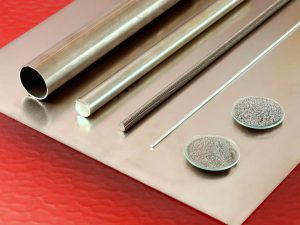
This file is licensed under the Creative Commons Attribution 3.0 Unported license.
Aviation
Utilized Properties: Lightweight, high specific strength, high-temperature resistance, corrosion resistance
Specific Uses: Aircraft frames, landing gear, fasteners, rotating components of aircraft engines like fans, compressors, and blades
Aerospace
Utilized Properties: Lightweight, high specific strength, high-temperature resistance, corrosion resistance
Specific Uses: Rocket engines, artificial satellite shells, fuel tanks, pressure vessels, crewed spacecraft cabins, etc.
Ships
Utilized Properties: Corrosion resistance, high specific strength
Specific Uses: Submarine pressure hulls, propellers, waterjet propellers, seawater heat exchange systems, ship pumps, valves, and pipelines
Weapons
Utilized Properties: Lightweight, high specific strength, corrosion resistance
Specific Uses: Armored materials for tanks and armored vehicles, components for artillery shells, mortar bases, etc.
Marine Engineering
Utilized Properties: Corrosion resistance, high specific strength
Specific Uses: Pipelines for seawater desalination, pumps, valves, etc. used in marine oil drilling
Biomedical
Utilized Properties: Good biocompatibility, corrosion resistance, non-magnetic, shape memory function
Specific Uses: Artificial joints, dental and orthodontic implants, pacemakers, cardiovascular stents, surgical instruments
Sports Equipment
Utilized Properties: Lightweight, high specific strength, corrosion resistance
Specific Uses: Golf club heads, tennis rackets, badminton rackets, billiard cues, climbing poles, ski poles, ice skates, etc.
Consumer Goods
Utilized Properties: Lightweight, high specific strength, corrosion resistance
Specific Uses: Glasses frames, watches, canes, fishing rods, kitchenware, digital product housings, handicrafts, decorations, etc.
Chemical Metallurgy
Utilized Properties: Corrosion resistance, high-temperature resistance
Specific Uses: Used in electrolytic cells, reactors, distillation columns, concentrators, separators, heat exchangers, pipelines, electrodes, etc., in industries such as chlor-alkali, soda, plastics, petrochemicals, metallurgy, and salt production
Construction
Utilized Properties: Corrosion resistance, low thermal expansion, high specific strength, environmentally friendly, energy-saving, good color
Specific Uses: Load-bearing springs, connecting rods, bolts, etc.
Power
Utilized Properties: High-temperature resistance, corrosion resistance
Specific Uses: Nuclear power condensers, turbine blades, etc.
Automotive
Utilized Properties: High-temperature resistance, corrosion resistance
Specific Uses: Connecting rods, tailshaft springs, high-performance car exhaust systems, etc.
The downstream applications of titanium alloy are diverse and encompass a wide range of industries, showcasing its versatility and meeting the robust demand in the market.
Titanium in Consumer Tech and 3D Printing
Why is titanium good for iPhone?
Leading consumer electronics brands are more frequently incorporating titanium alloys into components.
In July 2023, Honor launched the Magic V2 foldable phone with a hinge and axis cover utilizing titanium alloy 3D printing technology for mass production – a first for smartphones.
That September, Apple unveiled the titanium alloy-bodied iPhone 15 Pro/Pro Max and Apple Watch Ultra2, indicating they are actively exploring 3D printing of titanium alloy parts. Major manufacturers are tapping into titanium’s strength, corrosion resistance and biocompatibility through innovative additive techniques.
As 3D printing of titanium alloys for consumer electronics grows, it signals the advanced material may see broader usage across industries through customized, resilient designs optimized for diverse applications.
| Brand | Product Model | Product Type | Titanium Alloy Parts Used | Description |
| Apple | iphone 15 Pro/Pro Max | Smartphone | Middle Frame | The titanium outer frame is welded to the aluminum inner using solid-state diffusion, providing high strength with less weight. Use of titanium saved around 20g per iPhone 15 Pro/Pro Max. |
| Apple | Apple Watch Ultra/Ultra 2 | Smartwatch | Case and Buckle | Adopts a 49mm titanium alloy case, with a corrosion-resistant titanium alloy buckle. |
| Honor | Foldable Magic V2 | Smartphone | Hinge and Axle Cover | Equipped with a titanium alloy hinge, constituting 91% of the metal structure. |
| Samsung | Galaxy S24 Ultra | Smartphone | Middle Frame | It will benchmark the iPhone 15 Pro Max, which also uses titanium alloy. |
| Samsung | Galaxy Watch 5 Pro | Smartwatch | Case | The titanium alloy case is more resistant to scratches. The stainless steel screws have also been replaced with titanium alloy. |
| Xiaomi | Xiaomi 14 Pro | Smartphone | Middle Frame | Xiaomi 14 Pro is the world’s first Android phone with a titanium metal middle frame. |
Titanium alloy’s lightweight and high strength make it well-suited for consumer electronics. Features like lightweight construction and mechanical strength are imperative for components inside smartphones and other consumer devices. Take the internal middle frame that provides structural support – it demands high strength, hardness and resistance to corrosion over the lifetime of frequent use and exposure.
Traditionally, materials for mid-to-high-end phone frames include stainless steels (304 and 316L) as well as aluminum alloys (AL6063, AL7075). Compared to these options, titanium alloy possesses benefits of both lightweight design and robust durability well-tailored for the demands of consumer tech product construction.
| Material | Density (g/cm³) | Tensile Strength (MPa) | Yield Strength (MPa) | Brinell Hardness (HB) | Elongation at 85(%) | Melting Point (°C) |
| TC4 | 4.43 | ≥895 | ≥825 | 270-310 | ≥10 | 1662-1668 |
| Stainless Steel SUS304 | 7.93 | ≥480 | ≥177 | ≤187 | ≥40 | 1375-1450 |
| Stainless Steel SUS316L | 8.03 | ≥515 | ≥205 | ≤187 | ≥40 | 1398-1454 |
| Aluminum Alloy AL6063 | 2.75 | ≥205 | ≥170 | 95 | ≥9 | 568-652 |
| Aluminum Alloy AL7075 | 2.81 | ≥524 | ≥462 | 150 | ≥11 | 475-635 |
Material Performance for Smartphone Middle Frame (Titanium Alloy, Stainless Steel, Aluminum Alloy)
Titanium Process Comparison: 3D Printing vs Traditional CNC
High production costs have hindered broader titanium alloy adoption in consumer electronics.
Traditionally, phone structural components favor stainless steels for their shine and aluminum alloys for weight savings. However, stainless steels lack the desired lightness while aluminum alloys have inferior hardness.
On the other hand, titanium alloy offers hardness surpassing stainless steel but with half the weight of the same volume—an ideal balance. Unfortunately, difficulties and low yields from conventional titanium processing methods result in substantial expenses that curtail its use.
3D printing presents advantages over traditional techniques through its layer-by-layer, digitally controlled construction capability. Rapid prototyping brings customization, minimized waste, precise forming, and lightweight, complex designs to reality.
Mainstream 3D printing technologies currently employ selective laser melting, electron beam melting, and laser engineered net shaping using feedstock like titanium alloy, aluminum alloy and stainless steel. The technology stands to drive titanium integration by improving manufacturing efficiencies and lowering costs.
3D Printing for Smartphone Middle Frames
Traditionally, CNC vertical machining centers are employed to process phone middle frames. As the central support structure securing the display, rear case, and internals, the middle frame demands high strength, hardness, and corrosion resistance. Common materials include stainless steels (SUS304, SUS316L) and aluminum alloys (AL6063, AL7075).
3D printing shows promise for producing titanium alloy middle frames. Being a complex, intricately designed hidden component housing all internals, traditional CNC methods for titanium alloy middle frames require specialized tooling and suffer lower yields due to challenges from machining the material.
Therefore, 3D printing titanium alloys could offer a solution, with success already demonstrated in aerospace mass production applications. The main constraint is presently higher costs at large scale production levels. However, additive techniques may eventually drive down expenses while facilitating optimized, durable designs ideal for this critical smartphone element.
3D Printing for Smartphone Hinges
Manufacturing hinges for foldable phones via traditional means poses challenges. Hinges enable screens to smoothly fold and unfold, requiring precision engineering coordinated with flexible display structures. This complexity leads to intricate production processes and lower finished yields.
Given hinges may involve over 100 customized components performing small-scale movements, manufacturability adds significant expense. Research cites the Galaxy Fold 1’s mechanical modules (including hinges) cost approximately $87.50 compared to $29.80 for standard phones like the Galaxy S9+ due to multi-step fabrication needs.
3D printing and metal injection molding show great potential as mainstream hinge solutions. Whereas conventional methods sequence multiple steps like molding, stamping and high-precision CNC work, additive and MIM offer integrated, cost-effective processes through high design control for complex geometries and economies of scale. Their capabilities address the dimensional accuracy and mass-producibility required to bring hinged consumer devices into affordable production.
3D Printing for Smartwatches
Titanium alloy is commonly used in smartwatches, primarily through metal injection molding (MIM) processing. MIM technology currently dominates as it enables the near-net shaping of complex, micro-scale structures well-suited for wearables. It delivers high-dimensional accuracy and precision critical for small components.
However, with ongoing developments in 3D printing efficiency, cost effectiveness and capabilities, additive manufacturing of titanium watch parts is increasing feasibility. Reports indicate the Apple Watch Ultra already utilizes binder jetting 3D printing for elements like the digital crown, side button and action button.
Financial news sources further mention Apple actively exploring binder jetting for Apple Watch Series 9 chassis production. This novel approach could both shorten production timelines and reduce material waste compared to traditional CNC, making the process more environmentally sustainable. Ongoing refinement of these additive techniques aims to displace conventional manufacturing across consumer product domains.
Conclusion
Additive and subtractive manufacturing processes complement one another for titanium parts. Generally, 3D printing is better suited for low-volume prototyping and production runs due to setup efficiency.
However, at higher volumes such as several hundred thousand pieces or more, MIM becomes more cost-effective than 3D printing. MIM is also typically limited to lighter components under 500g.
Therefore, for larger titanium components, 3D printing is favored. Process selection also depends on the required surface finish – MIM delivers slightly better roughness below 2 microns, while 3D printing suits finish above 3 microns. For assemblies demanding sub-1 micron precision, CNC remains necessary for post-processing.
Future Applications of Titanium
As consumer electronics progress towards higher performance, titanium alloy use will likely proliferate. Its high strength and low density allow for reduced thickness and weight without compromising robustness. Looking ahead, structural applications of titanium alloy will grow across device categories like tablets, laptops and additional smartphone components.
Advances in 3D printing are overcoming titanium alloy processing challenges. As the technology, costs, and properties of additive techniques continue to develop in accordance with manufacturer needs, their adoption will accelerate. 3D printing shows strong potential to expand titanium integration within consumer electronics by addressing manufacturing barriers and realizing optimized, yet economical designs across a broad range of scales.
Subscribe to our Newsletter
3DPResso is a weekly newsletter that links to the most exciting global stories from the 3D printing and additive manufacturing industry.



